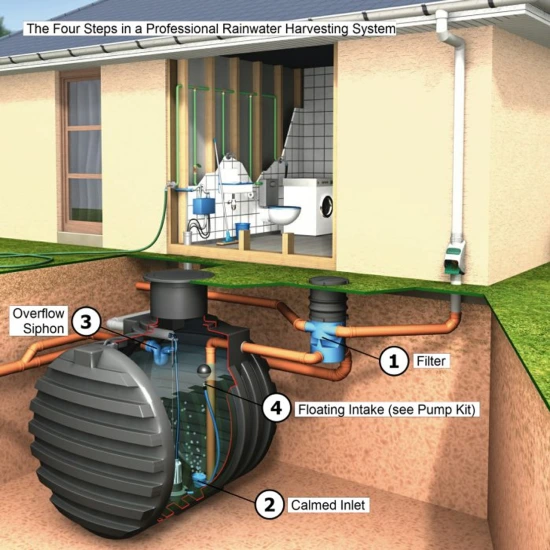In our country, water consumption is a significant cost item for some industries, with agriculture being one of the primary sectors. Rainwater collection systems are installed in some agricultural areas using water tanks. The rainwater harvesting system includes all the equipment necessary for collecting, storing, and using rainwater. These systems generally include a rainwater collector (such as a roof), an underground tank, a filter system, a pump, and a distribution system.
The installation of a rainwater harvesting system involves first designing and installing the roof or other rainwater collectors. Then, the tank and filter system are installed to clean and store the collected water. Finally, a pump and distribution system are installed to distribute the water for use.
The pumps used for rainwater harvesting systems are generally continuously operating and pump water from either an underground tank or a surface water source. These pumps are usually used to increase the output pressure of the fluid and are selected based on the drainage requirements of the water system.
The pumps used can be a centrifugal pump, a surface-mounted pump, or a submersible pump, and the critical criteria for selection are the circulation rate of the water, flow rate, response pressure, operating time, and operating temperature.
How Can We Install a Rainwater Collection System in Our Home?
Rainwater harvesting systems are designed to increase the amount of usable water for meeting your home's water needs. This helps reduce your home's water bill and reduces the consumption of water sources. On the other hand, it allows the rainwater to be collected before it reaches settlement areas or treatment facilities. This helps reduce the strain on water sources and has less of an impact on the environment. To install a rainwater collection system in your home, you can follow the steps below:
Planning: Before you start, determine the size of your home's roof, your water needs, and your storage needs. This is essential to determine the necessary equipment and costs for installing the system. Determine the size of your home's roof. This is important to determine the necessary equipment and costs for installing the system. Determine your water needs. This is important to determine the necessary storage requirements for installing the system. Additionally, check the local laws and regulations in your settlement area. This is important to determine the system's compliance with local laws.
Installation of roof collectors: Install rainwater collectors on your roof. This can be a hose or a roof covering system made of materials such as plastic or aluminum. These systems are mounted on your roof or wall and collect water into a hose or container.
Water storage system: Install an underground or above-ground tank. These tanks are usually made up of products such as plastic horizontal water tanks. This allows for the filtration and storage of water. Rainwater harvesting systems generally require tanks with a capacity of at least 1,000 gallons.
Filtration system: Install a filtration system to ensure the water is clean and safe to use. The filter system should be installed between the tank and the pump to remove debris and contaminants from the water.
Pump and distribution system: A pump allows water to be made available for use in your home. This allows the water to be lifted from an underground tank and distributed to the faucets or showers in your home. There are many different types of pumps available, such as centralized pumps, surface-mounted pumps, submersible pumps, but the selection should be based on factors such as stored amount, circulation rate, flow rate, response pressure, operating time, and operating temperature. Hoses or piping systems are used to distribute water to the faucets or showers in your home. These hoses or pipes are generally made of materials such as polyethylene or PVC and carry water to the usage points in your home.
Test and control: After installation is complete, test the storage system and all connections to identify leaks or other issues. Also, periodically check and maintain the system as needed.
These roadmaps generally provide information on how a rainwater harvesting system can be installed. However, compliance with local laws, regulations or recommendations from local authorities, particularly those specific to your location, is necessary to ensure compliance.


 EN
EN
 DE
DE
 FR
FR
 IT
IT
 ES
ES
 PT
PT
 RU
RU
 AR
AR
 BG
BG
 SR
SR
 GR
GR
 SQ
SQ
 RO
RO
 PL
PL
 HU
HU
 CZ
CZ
 HR
HR
 AZ
AZ
 GE
GE
 AM
AM
 IL
IL
